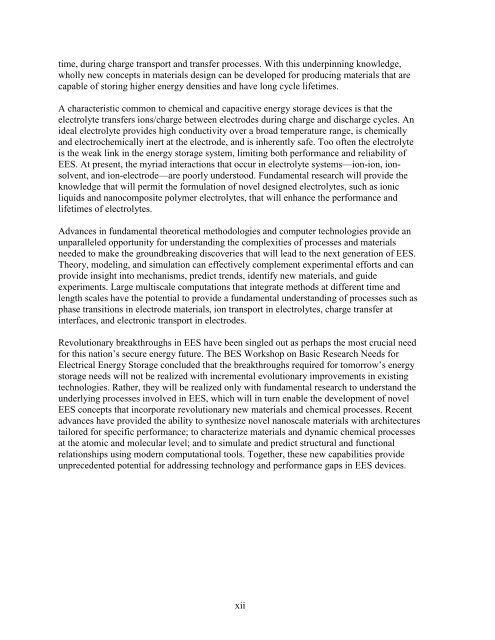Basic Research Needs for Electrical Energy Storage: Report of the ...
Basic Research Needs for Electrical Energy Storage: Report of the ...
Basic Research Needs for Electrical Energy Storage: Report of the ...
Create successful ePaper yourself
Turn your PDF publications into a flip-book with our unique Google optimized e-Paper software.
time, during charge transport and transfer processes. With this underpinning knowledge,<br />
wholly new concepts in materials design can be developed <strong>for</strong> producing materials that are<br />
capable <strong>of</strong> storing higher energy densities and have long cycle lifetimes.<br />
A characteristic common to chemical and capacitive energy storage devices is that <strong>the</strong><br />
electrolyte transfers ions/charge between electrodes during charge and discharge cycles. An<br />
ideal electrolyte provides high conductivity over a broad temperature range, is chemically<br />
and electrochemically inert at <strong>the</strong> electrode, and is inherently safe. Too <strong>of</strong>ten <strong>the</strong> electrolyte<br />
is <strong>the</strong> weak link in <strong>the</strong> energy storage system, limiting both per<strong>for</strong>mance and reliability <strong>of</strong><br />
EES. At present, <strong>the</strong> myriad interactions that occur in electrolyte systems—ion-ion, ionsolvent,<br />
and ion-electrode—are poorly understood. Fundamental research will provide <strong>the</strong><br />
knowledge that will permit <strong>the</strong> <strong>for</strong>mulation <strong>of</strong> novel designed electrolytes, such as ionic<br />
liquids and nanocomposite polymer electrolytes, that will enhance <strong>the</strong> per<strong>for</strong>mance and<br />
lifetimes <strong>of</strong> electrolytes.<br />
Advances in fundamental <strong>the</strong>oretical methodologies and computer technologies provide an<br />
unparalleled opportunity <strong>for</strong> understanding <strong>the</strong> complexities <strong>of</strong> processes and materials<br />
needed to make <strong>the</strong> groundbreaking discoveries that will lead to <strong>the</strong> next generation <strong>of</strong> EES.<br />
Theory, modeling, and simulation can effectively complement experimental ef<strong>for</strong>ts and can<br />
provide insight into mechanisms, predict trends, identify new materials, and guide<br />
experiments. Large multiscale computations that integrate methods at different time and<br />
length scales have <strong>the</strong> potential to provide a fundamental understanding <strong>of</strong> processes such as<br />
phase transitions in electrode materials, ion transport in electrolytes, charge transfer at<br />
interfaces, and electronic transport in electrodes.<br />
Revolutionary breakthroughs in EES have been singled out as perhaps <strong>the</strong> most crucial need<br />
<strong>for</strong> this nation’s secure energy future. The BES Workshop on <strong>Basic</strong> <strong>Research</strong> <strong>Needs</strong> <strong>for</strong><br />
<strong>Electrical</strong> <strong>Energy</strong> <strong>Storage</strong> concluded that <strong>the</strong> breakthroughs required <strong>for</strong> tomorrow’s energy<br />
storage needs will not be realized with incremental evolutionary improvements in existing<br />
technologies. Ra<strong>the</strong>r, <strong>the</strong>y will be realized only with fundamental research to understand <strong>the</strong><br />
underlying processes involved in EES, which will in turn enable <strong>the</strong> development <strong>of</strong> novel<br />
EES concepts that incorporate revolutionary new materials and chemical processes. Recent<br />
advances have provided <strong>the</strong> ability to syn<strong>the</strong>size novel nanoscale materials with architectures<br />
tailored <strong>for</strong> specific per<strong>for</strong>mance; to characterize materials and dynamic chemical processes<br />
at <strong>the</strong> atomic and molecular level; and to simulate and predict structural and functional<br />
relationships using modern computational tools. Toge<strong>the</strong>r, <strong>the</strong>se new capabilities provide<br />
unprecedented potential <strong>for</strong> addressing technology and per<strong>for</strong>mance gaps in EES devices.<br />
xii
















